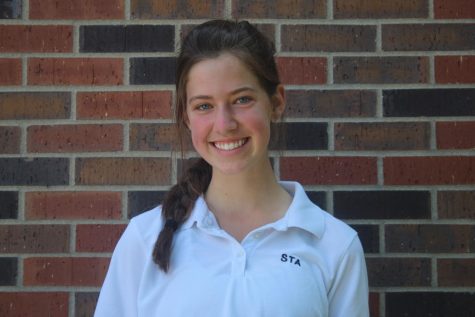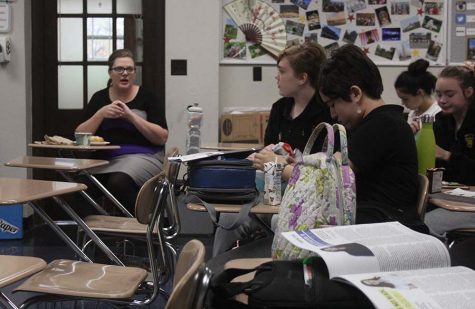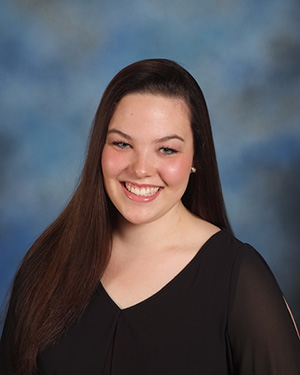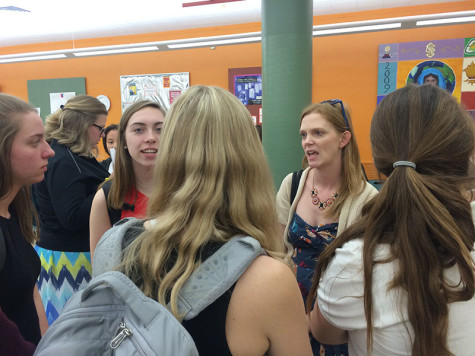Spanish teacher implements controversial participation assessment

November 15, 2011
by Rowan O’Brien-Williams
[nggallery id=162]
This year, Spanish teacher Julia Gargallo implemented a participation points system in her Spanish III and IV classes. According to Gargallo, the only teacher using this specific system, each student completes a table with ten spots, writing the sentence the student said in Spanish. While some students find this method effective, others do not. Either way, every student turns in the tables once every three weeks. Gargallo said she uses the table to assess the extra effort that students put into saying things in Spanish.
“There is the participation when the teacher asks a question to the student and to be fair and ask the same number of questions to everybody,” Gargallo said. “I don’t grade drilling activities.”
Gargallo thinks the participation tables have improved participation in her classes.
“When the professor from Rockhurst [University] was visiting [my Spanish] class she was amazed by how many people wanted to participate,” Gargallo said.
Gargallo said the participation tables have resulted in positive outcomes only.
“So far I don’t see any negatives,” Gargallo said. “[The participation tables] give control to students and teach responsibility to students because some students participate but they have lost the table.”
 In addition to encouraging students to speak Spanish, these participation tables factor into students’ grades. Gargallo said she records the grades in Powerschool, giving one point for each of the ten parts of the table.
In addition to encouraging students to speak Spanish, these participation tables factor into students’ grades. Gargallo said she records the grades in Powerschool, giving one point for each of the ten parts of the table.
Senior and Spanish IV student Haley Winslow recognizes the benefits of the table and the grading system that goes along with it.
“The table is basically just used to pressure students into talking in Spanish because otherwise we wouldn’t talk in Spanish,” Winslow said. “It’s motivation. I also really like it and make sure I do it because it’s extra points for me.”
Winslow also thinks the table is innovative in getting students involved in class.
“[Gargallo] really wants us to improve our skills for college and tries to come up with new ways to get us all involved because once you get to Spanish IV everyone is expected to participate and that’s [Gargallo’s] way of making sure of it,” Winslow said.
On the other hand, Senior Spanish IV student Jennifer Blake does not believe in participation points in general.
“I feel like [participation points are] elementary,” Blake said. “I think now that we’re in high school we shouldn’t get these bonus points. People need to participate on their own. [Participation] shouldn’t be for a grade; that shouldn’t be your incentive.”
Although Blake doesn’t believe in the system, she follows it.
“I do it to just get my ten points because I don’t like talking in class,” Blake said. “I’m just not a talker.”
Blake said that overall, she is indifferent about the system.
“It’s not bad but it’s not my favorite thing to do,” Blake said. “I feel like it’s just busy work.”
Blake also questions the effectiveness of the table.
“Some people don’t participate fully,” Blake said. “Like I know some people just write stuff [on the table without saying it in class]. I mean it’s just what you make of it.”
Gargallo hopes that students make good use of the participation table.
“[The table is] about empowering the students so they feel they have some control,” Gargallo said. “People who are usually quiet will participate and they didn’t participate in the past because didn’t feel pressure to fill the table.”











Vivi • Jan 26, 2015 at 7:45 pm
hii…!
is participation point system is a strategy or a method?
if You don’t mind, will You give me the theories of Post or the link of journal or rubric about Participation Point System (PPS ) .. I’m a students who wants to write about this system in my graduating paper.. will You help me?